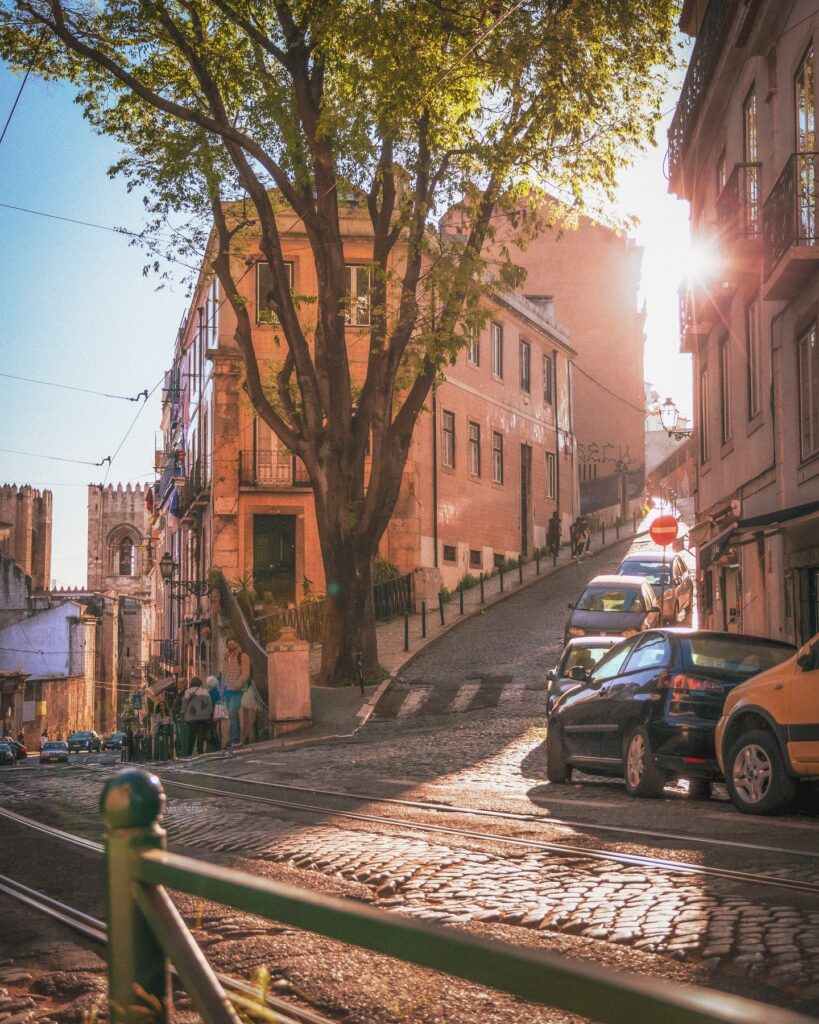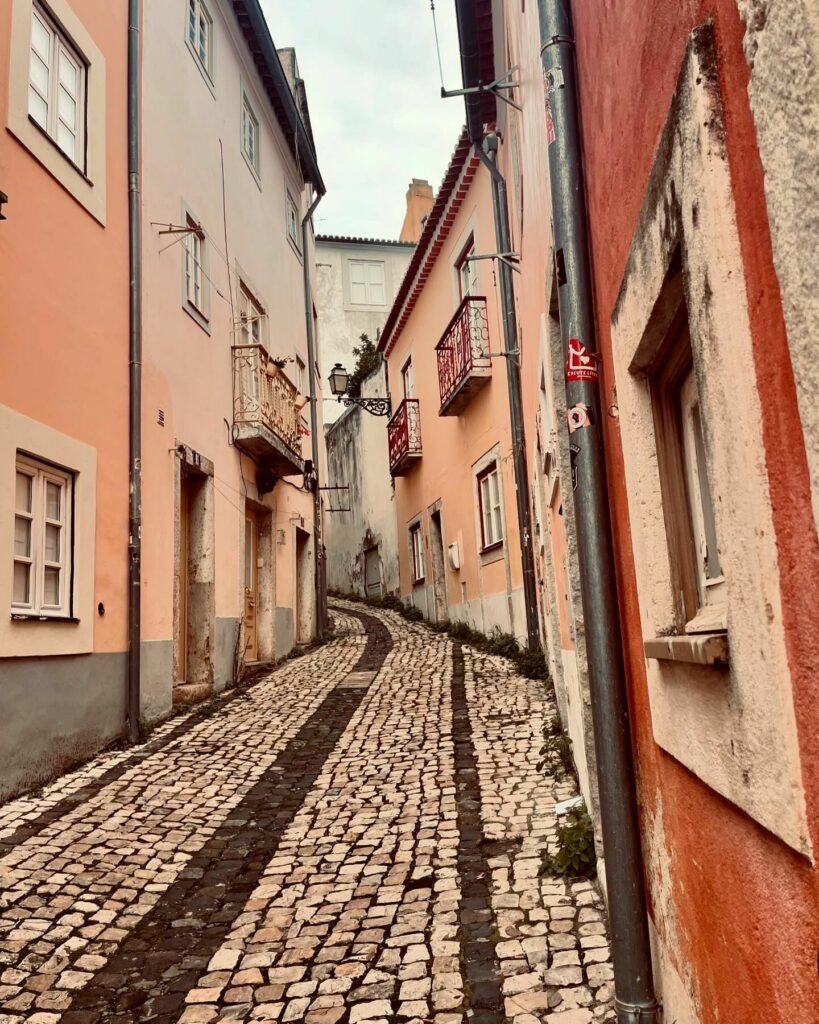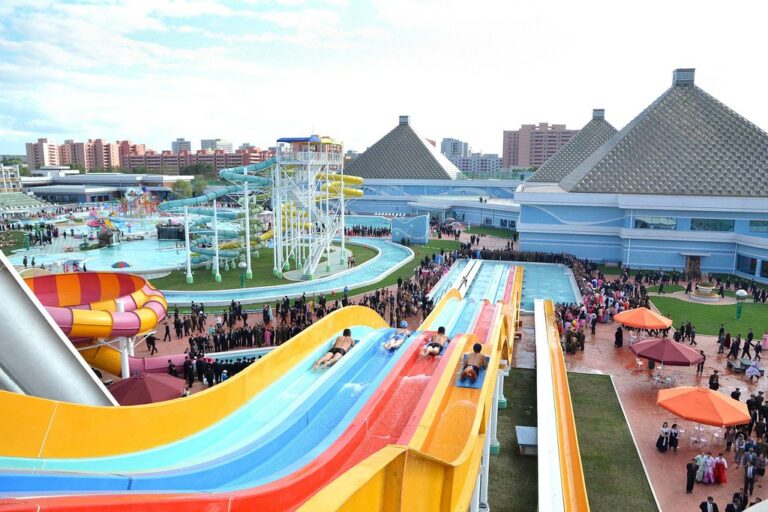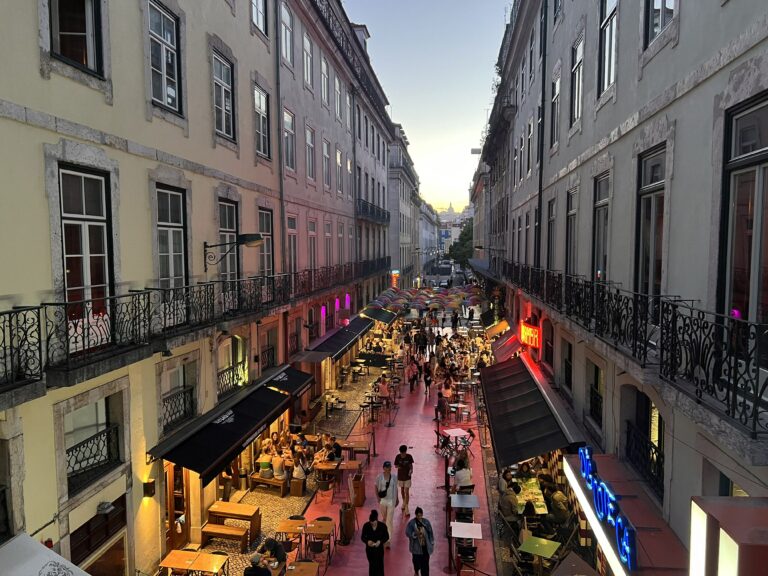YES, Lisbon is walkable. But bring along comfortable shoes to walk up and down the hills.
I love to walk around Lisbon, and before you know it, you’ve walked 10,000 steps because so much is happening that you don’t notice it.
The best sightseeing in the city is done on foot as traffic and finding parking are headaches.
Is Lisbon a Walkable City?

Yes, Lisbon is very walkable, but I recommend a few things to make it more enjoyable.
1. Lisbon’s Cobblestones and Sidewalks
In Lisbon, the sidewalks are paved with calcada portuguesa. These are small black-and-white tones creating designs on the pavement.
While it is beautiful and adds to the cobblestones, it can become extremely slippery. The more people walk over these stones, the smoother the surface becomes.
The surface becomes slick and dangerous during the rainy season, as puddles form in the worn-down tiles.
In Porto, all the sidewalks in the city center have been replaced, as they are dangerous when wet.
Still, the Portuguese capital is the outlier, keeping these sidewalks in the historic center.
While I have never fallen when walking over them, there were times I almost slid and needed to correct myself.
I recommend wearing comfortable walking shoes with a non-slip sole. Also, walk on the edge of the street instead of the sidewalk.
2. Lisbon’s Hills and Many Stairs

Lisbon is known as a complex city for walkers because it is hilly and very steep. Whether you are walking inland (south to north) from the waterfront or parallel (east to west, or vice versa) to the waterfront, there are hills.
Common uphill walks that pose a challenge in Lisbon:
- Martim Moniz Square to Restauradores Square – expect to walk 600 meters with a 40-meter (7% incline) elevation gain
- Cais do Sodre Station to Bairro Alto – the walking distance is 950 meters with a 123-meter (13% incline) elevation gain
- Fado Museum to the Porta do Sol Viewpoint – a walking distance of 400 meters with a 50-meter (12.5% incline) elevation gain
Still, that is not all. Some hills have sloping sidewalks lined with Portuguese tiles that become slippery on steep inclines.
The only other way to walk in Lisbon is to take a flight of stairs; some are worn out and uneven. So always be careful.
Hot Tip🔥: Walking is one of the most budget-friendly ways to spend time in Lisbon. But there are many other ways to visit Lisbon on a budget to save even more. Check it out today.
Planning On Going To Lisbon?
I’ve created a trip planner where you enter the number of days you’re going and what activities you want to do.
Based on your input, you then get an entire vacation planned with ideas.

3. The Weather Can Get Windy and Rainy
Lisbon can get hot during summer, and the winters are rainy. Wet feet can dampen your day, so bring along comfortable waterproof shoes. Bring your hat and sunscreen in summer, as there is little shade when walking.
Hot Tip🔥: Check out my post on what you can do in Lisbon when it rains.
Is Lisbon Easy to Walk Around? (+ Distances)
Yes, Lisbon is easy to walk around if you overlook the hilly streets. The historic center is relatively small, and the distances between major attractions are not too far apart.
Think of Arco da Rua Augusta as your center point. All the major tourist attractions are within a kilometer walking distance (semi-circle) from this point. In the other half of the circle, you walk towards the Tagus River.
Even the furthest attractions, like the Fado Museum and Time Out Market, are two kilometers apart. The only other barrier you will face walking from Point A to B is the hills.
While you may spend your trip in Lisbon around this semi-circle, I advise exploring other attractions, such as Belem and Cascais, which are further away. You can easily reach them by tram or train.
Walking in Lisbon With Kids
Lisbon can be challenging to walk around with kids, but it’s manageable and rewarding with some planning.
9 Tips For Walking in Lisbon With Kids
- Choose Comfortable Shoes: Lisbon’s cobblestone streets can be uneven, so opt for sturdy shoes with good support.
- Pack Snacks and Water: Keep your kids hydrated and happy with snacks and water.
- Utilize Public Transportation: Lisbon’s trams, buses, and funiculars are the best options for longer distances or hilly areas.
- Explore Child-Friendly Parks: Lisbon has many beautiful parks where kids can play and run around. Some popular choices include Jardim Amália Rodrigues and Parque Eduardo VII.
- Visit Interactive Museums: Museums like the Museu da Electricidade and the Oceanário de Lisboa offer interactive exhibits perfect for kids.
- Take a River Cruise: A cruise on the Tagus River offers stunning views of Lisbon and is a relaxing way to spend time with the family.
- Plan Rest Breaks: Take frequent breaks to rest and recharge, especially on hot days.
- Consider a Baby Carrier: If you have a young child, a baby carrier can be a convenient way to explore the city.
- Be Mindful of Traffic: Lisbon can be busy, so always cross the street at designated crosswalks.
5 Alternatives to Walk Around Lisbon

Lisbon rewards those who explore on foot and offers excellent public transportation to connect the dots traveling from Baixa to Belém. Here are my best options for getting around.
Here are the best things to do in Lisbon In September 2024
I’ll send you a list of the best things to do in September and every month moving forward from today.
It’ll be based on my personal experience of living and traveling around Lisbon for years. I’m sharing a lot of hidden gems. 🇵🇹
1. Take a Tuk-Tuk
These nimble three-wheeled taxis zip around the tight corners and steep hills other vehicles can’t access.
Taking a spin in a tuk-tuk makes for affordable, adrenaline-pumping sightseeing over short distances between neighborhoods like Barrio Alto and Chiado.
You can find them in most of the popular tourist areas, and you can book your tour online.
2. Uber
Rideshare apps like Uber typically operate in Lisbon, providing an alternative to traditional taxis.
Uber works well for point-to-point trips to attractions like Belem, far from the walkable downtown.
Uber is affordable, and most rides cost 5 Euros. The best part is that the drivers know all the shortcuts to save time.
I recommend avoiding taxis as they can be expensive.
3. The Metro System
Lisbon’s clean and efficient metro system makes hopping between districts like Rossio and Avenida da Liberdade a breeze. The subway also connects the city and the airport.
Purchase a reusable Navegante card and top it up to tap through turnstiles and ride. The metro cuts travel times across the hills and avoids tiring uphill climbs.
But be warned: The subway system does not have elevators or escalators, so you must go up a flight of stairs.
4. Take a Famous Tram Ride
Clanging yellow trams grind up steep streets too inclined for buses or the subway. The most famous lines are the scenic routes Tram 28 and the Elevador de Santa Justa.
However, the local commuter tram 12 is also handy for navigating areas like Graca. You can board with a regular metro card or invest in the Lisbon Card, which includes transport, discounts, and museum entry.
Hot Tip🔥: Check out everything you need to know about the Lisbon trams here.
5. Bike or Scooter
Riding a bike or e-scooter around the beautiful city has become famous thanks to flat seaside pathways and new bike lanes.
Take care navigating slippery cobblestones, but two wheels provide breezy freedom to see pretty neighborhoods line Lapa or Estrela differently.
How Accessible is Lisbon’s Public Transportation?
Lisbon’s public transportation system is generally well-suited for tourists, offering affordable fares and convenient access to major attractions. However, accessibility for individuals with disabilities can vary.
Elevators and escalators in metro stations provide easy access to exits, but maintenance can be inconsistent, leading to occasional outages. It can be particularly challenging for those who rely on these facilities.
The metro system has specific accessibility concerns. According to Cais do Sodre station, individuals with mobility problems who need to exit the station may need to buy a new ticket and backtrack to Baixa-Chiado station.
The other concern is that if visitors do this, there is no guarantee that the other elevators and escalators will work. The inconvenience can be frustrating for travelers with limited mobility.
To avoid unexpected accessibility issues, you should contact the call center before your journey to inquire about the current status of elevators and escalators.
The bus system is often a more accessible option for individuals with mobility issues. Approximately 80% of Lisbon’s buses are fully accessible for those with reduced mobility, featuring access ramps and sufficient space for wheelchairs.
Why Lisbon is so Walkable
Many areas in Lisbon are made purely for walking, where cars can’t pass. The city has prioritized pavements around the town, even though they are small in some places.
If you’re in a wheelchair, I recommend you stick to Avenida da Liberdade and the area close to the Tagus River unless you have a car to transport you.
Portugal has no violent crime rates and is one of the safest countries in Europe. Even walking at night is comfortable without any concerns. Furthermore, when walking, you see the city’s beauty from viewpoints, street art, plazas, and more.
The city in the older central districts is very pedestrian-scaled, making walking enjoyable without cars speeding by.
Walking Tours in Lisbon
While on the topic of walking, you can also book some great walking tours at GetYourGuide. They present different walking tours like:
- A walking tour of Belem
- Lisbon History, Story, and Lifestyle Walking Tour
- Food and Wine Tour
Hot Tip🔥: You can check out my self-guided Lisbon tour for free.
Wrap-Up: Is Lisbon Walkable?
Absolutely! Lisbon rewards foot exploration, especially around the scenic historic districts along the Tagus River or through pretty squares.
Cobblestones, hills, and extreme weather rarely deter people from attempting to walk everywhere. But mixing walking with efficient public transport like Lisbon’s metro, trams, and tuk-tuks makes covering more ground realistic.
Choosing centrally located accommodations in districts like Baixa, Avenida da Liberdade, and Alfama also ensures you can easily walk and sightsee throughout your stay.







